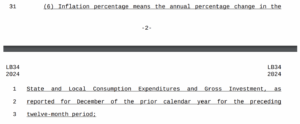Nebraska should tighten the inflation adjustment for its property tax cap
Nebraska lawmakers imposed a property tax cap in LB 34, which was passed during the 2024 summer special session. The property tax cap allows cities and counties to raise property taxes by 0% or inflation, whichever is greater.
So far, so good.
But not all inflation measures are created equally. In fact, the metric LB 34 uses to measure inflation is not actually a measure of inflation. It actually measures growth in government spending, and will allow local governments to continue to rapidly increase property taxes.
Capping property tax increases at inflation is the ideal tax cap structure. Normally, policymakers define inflation as the consumer price index (CPI), which measures the average growth in the cost of goods and services purchased by an American household. CPI captures a dollar’s loss in buying power from one year to the next, and accounts for the increase necessary to continue purchasing the same goods and services.
Yet LB 34 defines “inflation” as an entirely different measure called State and Local Consumption Expenditures and Gross Investment (SLCE). The SLCE does not measure inflation, but rather it measures the average growth in spending for state and local governments across the country. Thus, Nebraska’s tax cap allows property taxes to grow as rapidly as government spending is growing across the country.

In the last year-over-year reading, the SLCE is growing by 5.6% per year, while the consumer price index (CPI) is growing at only 2.9% year-over-year. In other words, when it comes to protecting homeowners from tax increases, Nebraska applies a measurement of inflation that is growing nearly twice as fast as actual inflation!
The discrepancy is not just a one-year phenomenon. The SLCE has consistently increased more rapidly than inflation.
| SLCE | CPI | |
| 1-year | 5.6% | 2.9% |
| 5-year | 31.6% | 22.6% |
| 10-year | 60.2% | 32.0% |
The reason the SLCE grows more rapidly than inflation is because government spending tends to outpace growth in purchasing power, which is the entire reason why property taxes need to be capped.
However, the SLCE cap will not provide sufficient protection against Nebraska’s rapidly-growing property tax burden. This makes sense since the SLCE measures an average of state and local government spending growth, which means it is not even focused on disciplined local governments. High tax jurisdictions in New York and California heavily weight the SLCE measure.
In fact, Nebraska property taxes have been growing nearly in line with the growth in SLCE over the last decade. County property taxes are $865 million as of 2023, while city and villages levied $588 million. So, if the tax cap enacted in LB 34 has been enacted a decade ago, it would not have stopped any of the county tax increases that have occurred over the last 10 years. City and village property tax growth might have been marginally restrained, depending on how much of the growth in their property taxes was attributable to real new growth (which is not subject to the cap).
The SLCE would allow for 7.7% growth for 2022-2023 increases, 32.0% for property tax increases from 2018-2023, and 54.1% increase for tax increases from 2013-2023.
Note: These measurements of SLCE and CPI are different from the comparison between SLCE and CPI above because Nebraska property tax data is only updated to 2023, and so the SLCE and CPI measurements are used for the parallel timeline to the property tax data.
| Counties | Cities and Villages | SLCE | CPI | |
| 2022-2023 | 6.7% | 9.3% | 7.7% | 7.7% |
| 2018-2023 | 29.4% | 39.1% | 32.0% | 20.8% |
| 2013-2023 | 53.2% | 70.1% | 54.1% | 28.8% |
Unfortunately, a tax cap can act as much like a floor as a ceiling. Local governments have an incentive to raise the maximum amount allowed by the levy each year to raise revenue while they can. This can make a tax cap an allowance as much as a deterrent, which is why the cap should be as strict as possible.
Local governments can enact tax increases above the level allowed by the cap. They just need voter approval to do so.
For these reasons, Nebraska should revisit its definition of “inflation” in LB 34 to bring more discipline to local government taxation. In order to protect Nebraska homeowners and ensure they approve significant tax increases, Nebraska law should define inflation as the normal consumer price index rather than the SLCE.
Until this change is made, lawmakers should recognize the cap for what it is – a spending growth measurement that will prevent the most absurd tax increases, but will allow most others to go through.
